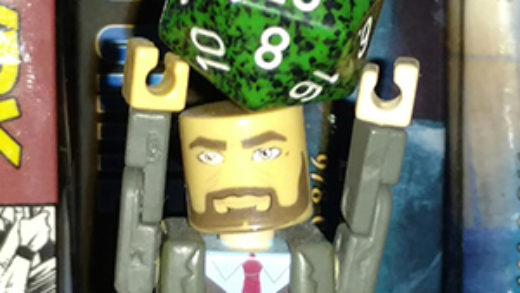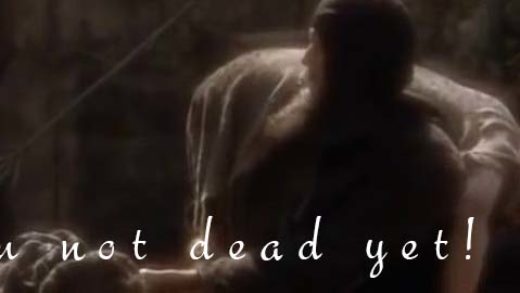For many gamers, the roll of the dice and the success or failure that hinges on each roll is one of the keys to their enjoyment of playing role playing games. For me, though, combat often felt like a slog; a whittling down of hit points that slowed the pace and play of the game. I sought out rules-light system after system, looking to find what I wanted in physical conflict in an RPG: action, not roll-the-dice combat. I didn’t know this action in gaming is what I was looking for at the time, but a return to classic RPG-style gaming in a Pathfinder campaign made me realize that it wasn’t (always) the combat system that slowed the game down, it was how combat was portrayed–and that any set of players and GM could instill the combat with action over simple dice rolling.
A note before I begin in earnest: There are two different schools of thoughts regarding the Game Master’s dice rolls. Some believe that the rules for both player and GM should be the same, to “let the dice fall where they may.” I am much more in line with the idea that the GM should be making sure everyone is entertained and that the dice rolls may impede that–not that the GM is above dice rolls, but that sometimes they may need to be fudged for maximum entertainment and pacing of the game session.
The Price on Pacing
In a typical session character interactions, puzzle-solving, and exploring happen in relative real-time to the players. Actions like travel, waiting, and sleeping often work in a compressed timeline separate from real life. (At least, I hope so. If your group is acting out entire space flights in real time please comment below and tell me about it. In real time.) When it’s time for combat, however, the in-game events get stretched out as combatants take turns, each performing their own task in reaction to another. Pacing can slow even further when rule books need to be consulted or sideline discussions regarding a decision and explanation need to occur. These turns in a round are often called actions, but very rarely does a round of combat feel much like an action scene in a book or movie. (Unless it’s one of those overly descriptive books or a very stylized movie.) I don’t think there’s a solid way to make combat occur in a 1:1 ratio of game time vs player time, but there are some ways to make a round of combat feel more like action and less like a board game.
Everything Happens At Once
Combat in RPG systems–from the rules-heaviest to the rules-lightest–typically consist of players making some sort of initiative roll then acting out turns. One of the strategies I’ve seen used and have used to a relative degree of success is to have each player announce their desired action for the turn from lowest initiative to highest but not yet make the action. So, the “slowest” or “last acting” player character would state their desired action (but not roll for it), then the next slowest player, and so on. This gives the characters with a higher initiative not only the advantage of going first, but the greater illusion that they read the room faster and have a better idea of how things might end up. Combat would then unfold in standard initiative order, but with penalties for any requested changes in announced action, a surprise reaction to the way events are unfolding. In this way, a round of combat is happening for the characters all at once, not just taking turns with the lowest initiative having an advantage of seeing the battle unfold and being able to act accordingly.
Mooks Act (And Fall) As A Group
This doesn’t always apply, but unless the game has a particular focus on combat, don’t stress about the hit points (or whatever your system of choice calls them) for general mooks. Let them be treated as a group when it comes to defeat. If one or two fall and the players feel like they’ve been successful overall, then allow the group to be swept aside. In most games PCs are movers and shakers of their universe–they might not always succeed, but very rarely should they be stopped by some mooks.
Have Mooks Level Up
Conversely, if the players do fail in a battle against their rank-and-file opponents, then maybe one of those more standard enemies become more powerful and appear on the battlefield again at some later point to challenge the PCs. This doesn’t always work depending on the campaign and shouldn’t happen often, but it can make even a defeat seem like its moving the plot along instead of being a random pitfall caused by bad tactics or dice rolls gone awry.
Have A Layout And Share It
Providing a blueprint and placement of characters allows players to more easily visualize the scene. I would often pull out a whiteboard and LEGO minifigs to represent the combat area. Not only did this prevent characters from seemingly teleporting around the battle area, but it would often spark player imaginations, allowing them to use the scenery in combat, which, in turn, made every round feel unique and potentially more cinematic. (If the fight occurred in a public place it could also lead to collateral or property damage–adding potential story hooks to the overall campaign.)
Reward Cleverness and Descriptiveness
It can be more fun for the group to allow them to narrate the outcomes of their actions, both successful and failures. GMs may need to exercise prudence over a player so the described outcome more closely matches the dice roll. Just as GMs should moderate players, a surprising tactic or well-described outcome can also be rewarded. Perhaps allowing a clever attack to do more damage or have a greater impact on the battle than the roll indicated or a well-described failure doing less damage to the player. This encourages players to continue thinking about the combat space and role-playing their character even in battle, where so often character sheets start to look more like stat blocks.
When In Doubt, Wing It
When something happens in the action that the players and GM aren’t sure about, nothing can slow the game to a crawl more than having to pull out the rule book(s). Players not involved in the action can often become restless, especially if the rules are particularly nebulous or tricky. I find it’s much easier to take a logical course of action, typically in favor of the players, over looking up the rules. The player and I (as GM) will make a note of the questioned outcome and the events will continue speedily in game. Post-game, if the scenario may come up again, the player and I will look up the rules in question and agree that we follow the rules the next time around (now that we know them). This is also why it’s important for the GM to understand the rules of the system they’re running as much as possible, but it’s not always easy to keep all those rules straight.
No Optional Combat Rules That Add Complexity
A lot of systems offer more complex combat rules in the hopes of generating “realism.” However, these complex rules often require multiple additional dice rolls for a player or GM, take more time to resolve and exclude other players, and necessitate returning to the rule book in the middle of combat. GURPS Martial Arts may seem like a good idea, but every group I’ve been in favors action and getting to play their character over waiting for a single combat action between another player and the GM to complete.
Conclusion
Those were just some thoughts on how I and some of my fellow GMs make combat quicker and more engaging for our groups. The ideas may not work for everyone. A lot of people do enjoy a slower-paced, more nuanced combat session. But if you find your group tending to wander off a bit more once combat starts in your game, maybe something in the above will help.


Recent Comments